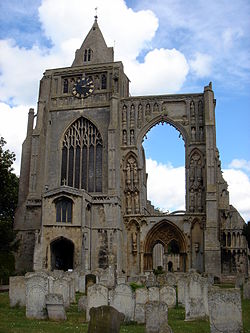Crowland Abbey
| Croyland Abbey | |
|
Crowland, Lincolnshire | |
|---|---|
 Croyland Abbey | |
| Parish: | |
| Location | |
| Location: | 52°40’35"N, 0°9’55"W |
| History | |
| Information | |
| Website: | crowlandabbey.org.uk |
Crowland Abbey (also spelled Croyland Abbey) is a Church of England parish church in Croyland in Lincolnshire. The church was formerly part of the ancient monastery known as Croyland Abbey. The Abbey rose to be a wealthy Benedictine foundation.[1]
History
A monk named Guthlac came to what was then an island in the Fens to live the life of a hermit and he dwelt at Croyland between 699 and 714. His life is the subject of a lengthy prose poem of the Anglo-Saxon period. Following in Guthlac’s footsteps, a monastic community came into being here in the 8th century. Croyland Abbey was dedicated to St Mary the Virgin, Saint Bartholomew and Saint Guthlac. During the third quarter of the 10th century, Crowland came into the possession of the nobleman Turketul, a relative of Osketel, Archbishop of York. Turketul, a cleric, became abbot there and endowed the abbey with many estates. It is thought that, about this time, Crowland adopted the Benedictine rule. In the 11th century, Hereward the Wake was a tenant of the abbey.
Crowland is well known to historians as the probable home of the Croyland Chronicle of Pseudo-Ingulf, begun by one of its monks and continued by several other hands.
The church contains a skull which is identified as the skull of the 9th century Abbot Theodore who was killed at the altar by Vikings. The relic used to be on public view until it was stolen from its display case in 1982. The skull was returned anonymously in 1999.
In 1537, the abbot of Croyland wrote to Thomas Cromwell, sending him a gift of fish: "ryght mekely besechyng yow lordship favorablye to accepte the same fyshe, and to be gud and favorable lorde unto me and my pore house". Despite these representations, the abbey was dissolved in 1539. The monastic buildings, including the chancel, transepts and crossing of the church appear to have been demolished fairly promptly but the nave and aisles had been used as the parish church and continued in that role.
The town was captured after a short siege by Parliamentarian forces in 1643[2] and this appears to have been when serious damage was done to the structure. The nave roof fell in 1720, the main south wall was taken down in 1744. The north aisle of the nave was refurbished and remains in use as the parish church.
John Clare wrote a sonnet entitled 'Crowland Abbey' which was first published in The Literary Souvenir for 1828 and reprinted in his last book, The Rural Muse in 1835.[3]
Organ
The abbey has a small two manual pipe organ. A specification of the organ can be found on the National Pipe Organ Register.[4]
Bell Tower
Crowland Abbey was the first church in Britain - and among the first in the world - to have a tuned peal or ring of bells (circa 986), and the chimes of the present bells were the first to be broadcast on wireless radio on 1 November 1925.[5] At 90 feet, the 'pull' or ropes are the longest in England.[6]
Burials
Waltheof II, Earl of Northumbria is buried here.
The churchyard contains the war grave of an airman of the Second World War.[7]
Outside links
| ("Wikimedia Commons" has material about Crowland Abbey) |
- Croyland Abbey Official Website
- Visitor's Guide to Croyland Abbey by Rev.d Stanley Swift
- Crowland (Croyland) Abbey video retrieved 18 December 2010
- Pboro Attractions
References
- ↑ National Monuments Record: No. 352270 – Crowland Abbey
- ↑ "Fenland Notes and Queries; April 1899, article on a piece of Parliamentarian propaganda.". http://boar.org.uk/ariwxo3FNQ761.htm.
- ↑ "Triumphs of Time: John Clare and the Uses of Antiquity, by Bob Heyes from the ''John Clare Society Journal'', no. 16 (July 1997)". Johnclare.info. http://www.johnclare.info/main/heyes.html. Retrieved 2012-08-17.
- ↑ "National Pipe Organ Register entry for Crowland". http://www.npor.org.uk/cgi-bin/Rsearch.cgi?Fn=Rsearch&rec_index=N14443.
- ↑ "Crowland Abbey bells to feature on BBC Radio 4 'Feedback' programme" Lincoln Diocesan Guild of Church Bell Ringers
- ↑ Carr, Barbara. "Bell tower: two firsts + a longest". http://www.geograph.org.uk/photo/3596664. Retrieved 16 March 2014.
- ↑ CWGC Casualty Record.
